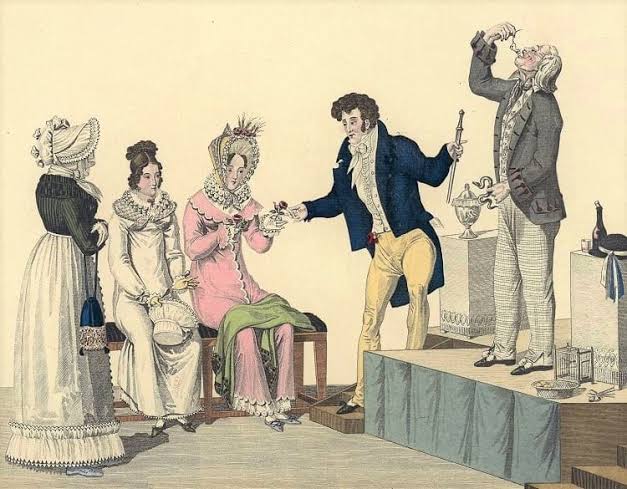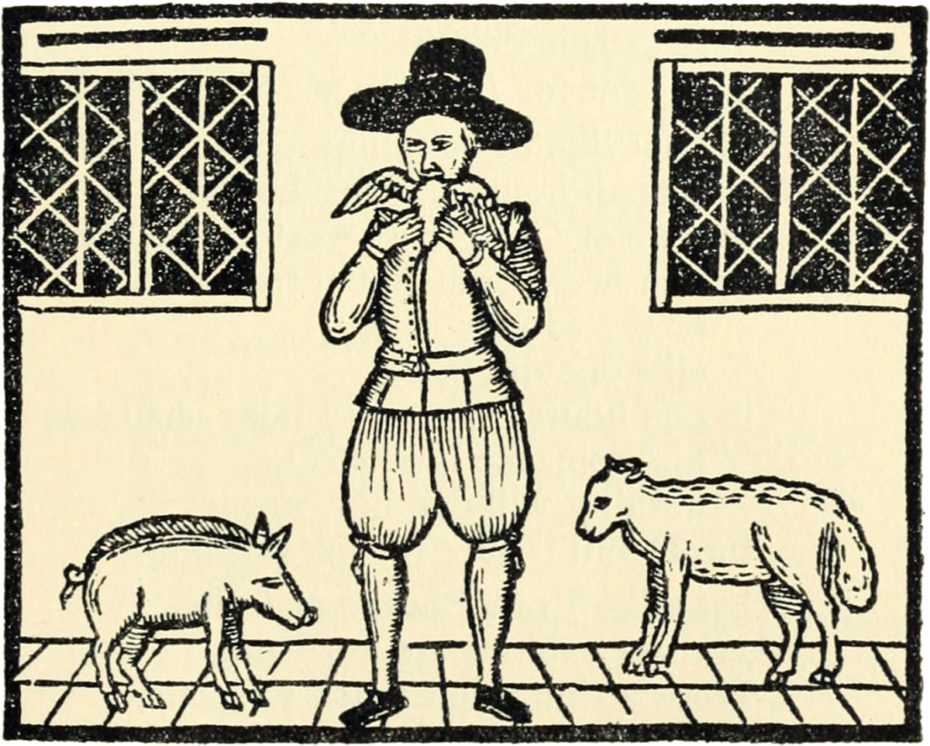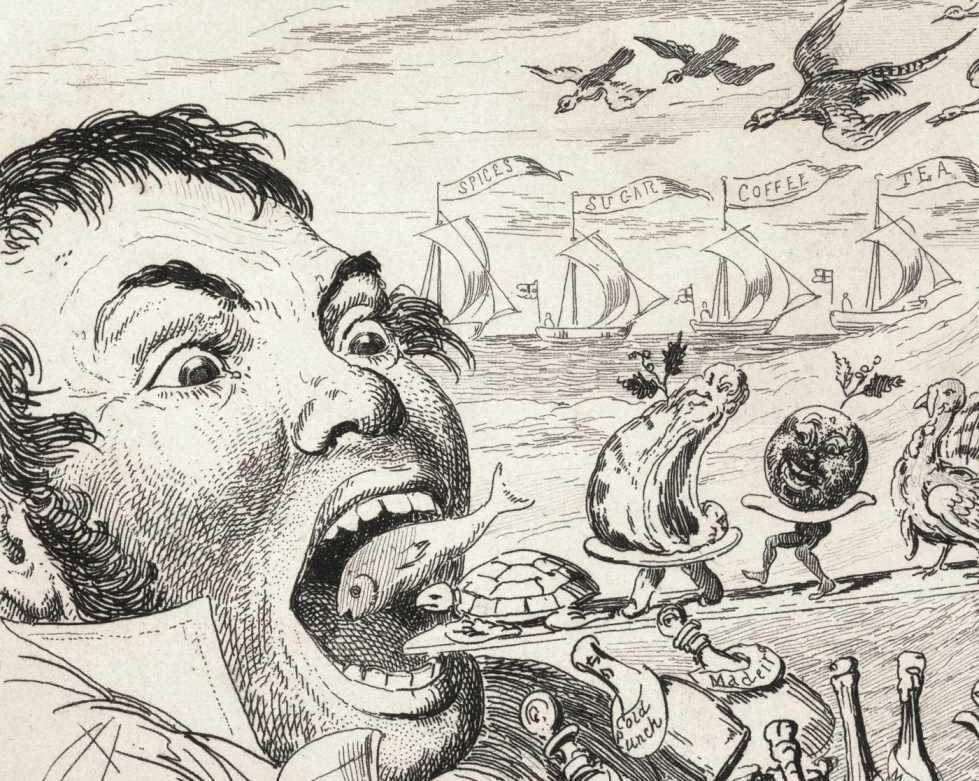Welcome to the enigmatic tale of Tarrare: A story about a French showman and soldier from the late 18th century, renowned for his extraordinary eating habits and insatiable appetite.
This man could consume amounts of food equivalent to his own weight in a single day. His diet included items as bizarre as corks, stones, and live animals.
Despite numerous attempts to cure his condition, his hunger remained unquenchable, leading him to a life of rejection, exploitation, and suffering.
The cause of Tarrare’s unusual behavior and physical condition remains a mystery, with theories ranging from hyperthyroidism to a damaged amygdala.
Early Life

Born circa 1772 near Lyon, France, Tarrare was a French entertainer and soldier, infamous for his extraordinary eating habits and insatiable hunger. His actual birth date and whether Tarrare was his birth name or a moniker are still mysteries.
His peculiar eating tendencies surfaced early in his life. As a teenager, he was capable of eating a quarter of a bullock, an amount equal to his own weight, all in a single day.
Unable to sustain his prodigious appetite, his parents were compelled to ask him to leave home. Subsequently, Tarrare spent several years traversing France with a group of thieves and prostitutes, surviving by begging and stealing food.
The Showman
His unique eating habits eventually landed him a job as a warm-up act for a traveling charlatan. In this capacity, he would captivate audiences by eating corks, stones, live animals, and a whole basket of apples.
His act gained enough popularity that he eventually brought it to Paris, where he performed as a street entertainer.
However, the advent of the War of the First Coalition marked a significant turning point in Tarrare’s life.
He enlisted in the French Revolutionary Army, but the standard military ration fell drastically short of satisfying his immense hunger.
Even when provided with four times the standard ration, Tarrare was perpetually famished. He would forage for any accessible food, even resorting to gutters and rubbish heaps.

His condition worsened due to persistent hunger, leading to his eventual hospitalization due to exhaustion.
During his hospital stay, Tarrare became the focus of a series of medical experiments aimed at testing his eating capacity. These experiments unveiled his ability to consume extraordinarily large quantities of food.
For example, he once consumed a meal meant for 15 people in one sitting. He also ate live cats, snakes, lizards, puppies, and swallowed eels whole without chewing.
Despite his abnormal diet, he remained underweight and exhibited no signs of mental illness, apart from an apathetic temperament.
Military Career
Interestingly, Tarrare’s unusual abilities drew the attention of General Alexandre de Beauharnais, who decided to utilize Tarrare’s abilities for military purposes.
Tarrare was appointed as a courier for the French army, planning to ingest documents, traverse enemy lines, and retrieve them from his stool once safely at his destination.
However, Tarrare’s first mission ended disastrously when he was captured by Prussian forces. He was brutally beaten, and subjected to a mock execution before being returned to French lines.
Following his harrowing ordeal as a military courier, Tarrare found himself back at the hospital, driven by a desperate need to find a remedy for his relentless hunger.
Did Tarrare Ate a Baby?
He was willing to undergo any procedure that might offer relief from his condition. Dr. Percy, the hospital’s chief surgeon, tried a variety of treatments, including laudanum, tobacco pills, wine vinegar, and soft-boiled eggs, but none of these efforts bore fruit.
Unable to rein in his hunger, Tarrare would stealthily leave the hospital to forage for scraps in gutters, refuse piles, and outside butcher shops.
His behavior took a disturbing turn as he was caught on multiple occasions trying to drink other patients’ blood. On one occasion he was caught attempting to consume bodies in the hospital’s morgue.
Despite these alarming actions, Dr. Percy remained committed to his experiments, and Tarrare stayed in the military hospital. However, the situation became untenable when a 14-month-old child mysteriously vanished from the hospital.
Tarrare was the immediate suspect and because of the severity of case, Dr. Percy was incapable to defend him.
The hospital staff drove Tarrare away following his cannibalistic nature. Following this incident, Tarrare the French showman, never returned to the hospital.
Autopsy of Tarrare

In 1798, four years later, Tarrare resurfaced in Versailles, gravely ill. He was bedridden and frail, plagued by what he believed was a golden fork lodged within him, which he had ingested two years prior.
He sought Dr. Percy’s assistance, hoping the surgeon could extract the object. However, upon examination, Dr. Percy diagnosed Tarrare with advanced tuberculosis.
Tarrare’s health swiftly declined. A month post-diagnosis, he began to suffer from persistent exudative diarrhea and passed away shortly thereafter.
His body decomposed rapidly, and despite the intrigue surrounding his condition, the hospital surgeons declined to dissect his body.
Nevertheless, a doctor named Tessier, intrigued by Tarrare’s unique internal anatomy and the potential presence of the golden fork, decided to conduct an autopsy.
The post-mortem examination of Tarrare’s body unveiled several peculiarities. His esophagus was extraordinarily wide, and upon opening his jaws, surgeons could peer down a spacious canal leading into his stomach.
His liver and gallbladder were notably enlarged, and his stomach was massive, ulcer-ridden, and occupied a significant portion of his abdominal cavity.
Despite a thorough search, the golden fork that Tarrare the French showman alleged to have ingested was never discovered.
Anatomy of Tarrare
Tarrare’s external appearance and demeanor were as remarkable as his internal structure.
Despite his excessive consumption, he maintained a slender physique and stood at an average height. At the tender age of 17, he weighed a mere 100 pounds.
He had unusually soft, fair hair, a remarkably wide mouth, and heavily stained teeth. When he hadn’t eaten, his skin was so loose that he could wrap the skin fold from his abdomen around his waist.
When satiated, his abdomen would expand “like a massive balloon”. His body was unusually warm to touch and he perspired profusely.
He was perpetually plagued by a foul body odor, described as so unbearable that one couldn’t stand within twenty paces of him. This odor would intensify post-meal.
Despite his vast food intake, he neither vomited excessively nor gained weight.
What was Wrong with Tarrare?

Tarrare and the root cause of his peculiar behavior and physical condition remains a mystery, as the French showman didn’t display any clear symptoms.
Hyperthyroidism has been proposed as a potential cause, as it can lead to extreme hunger, rapid weight loss, excessive sweating, heat intolerance, and fine hair.
Another hypothesis suggests that Tarrare might have had a damaged amygdala. The injuries to this part of the brain can result in polyphagia or excessive hunger.
However, these theories are purely speculative, and Tarrare’s condition continues to baffle the medical community. Tarrare’s case stands as a singular anomaly in the annals of medical history.
While there are other recorded instances of similar behavior from the same era, none of the individuals, except Tarrare, underwent an autopsy, and no contemporary cases mirror Tarrare’s.
His case continues to intrigue and bewilder medical practitioners and historians. Despite his extraordinary dietary habits, those who knew Tarrare during his lifetime did not observe any clear signs of mental illness or abnormal behavior.
Apart from a seemingly apathetic demeanor characterized by “a complete lack of energy and ideas”. This suggests that his condition was predominantly physical, rather than psychological.
The Hard Life of Tarrare
Tarrare, the French showman just didn’t battle his hunger. His life was marked by a series of tragedies, characterized by rejection, exploitation, and hardship.
From being expelled from his family home as a teenager, to his stint as a street performer and a military courier, and ultimately his demise from tuberculosis, his life was overshadowed by his relentless hunger and the physical and societal issues it engendered.
His case continues to be scrutinized as an extreme instance of pathological eating behavior and its potential origins. One is left wondering how Tarrare’s body processes such vast amounts of food.
And would modern medicine have cured Tarrare’s insatiable hunger? I’d love to hear your thoughts in the comments below.
